دعونا نهيئ المشهد. 🎭
أنت مدير مشروع وفريقك مستعد لاتخاذ الخطوة التالية في عملية تخطيط المشروع . لقد عملتم معًا على تطوير المفهوم وإنشاء استراتيجية إدارة المشروع لإحياء فكرتك
والآن، حان الوقت لاتخاذ الإجراءات اللازمة. 🥳
بمجرد كل خطوة من خطواتك خطة المشروع تم تخطيطها وأمامك، فهي جاهزة للدخول في مرحلة تنفيذ المشروع. ولكن قبل أن تجمع 200 دولار وتمرر "انطلق"، من المهم أن تكون على دراية بالتحديات والتغييرات التي يمكن أن تعيق المشروع أو حتى توقفه إلى أجل غير مسمى.
دع هذا الدليل يحفّزك على وضع استراتيجياتك حتى تتمكن من التغلب على تنفيذ المشروع كمحترف حقيقي. تابع معنا لمعرفة كل ما تحتاج إلى معرفته حول التنفيذ الناجح للمشروع، والثغرات التي قد تعيق تقدمك، و10 استراتيجيات لتنفيذ إدارة المشروع لمساعدة المديرين على البقاء على المسار الصحيح.
ما هو تنفيذ المشروع؟
يحدث تنفيذ المشروع بعد الانتهاء من مرحلة التفكير من خلال
خارطة طريق المشروع
. هذا هو الجزء الجيد - عندما تكون مستعدًا لوضع الأمور موضع التنفيذ فعليًا وتحقيق المشروع. يمكن أن تكون هذه أيضًا المرحلة الأكثر صعوبة لأنها الأطول والأكثر تطلبًا وتعقيدًا.
 يحتاج مديرو المشاريع إلى الحفاظ على تركيزهم واستعدادهم للتحول إلى محور العمل وأن يكونوا على دراية بتقدم المشروع وانتكاساته. بينما يعمل الفريق على تنفيذ الخطوات التي قمتم جميعًا بإنشائها، فإنك بصفتك مدير المشروع تشرف على تقدم الفريق وتدعمه من خلال:
يحتاج مديرو المشاريع إلى الحفاظ على تركيزهم واستعدادهم للتحول إلى محور العمل وأن يكونوا على دراية بتقدم المشروع وانتكاساته. بينما يعمل الفريق على تنفيذ الخطوات التي قمتم جميعًا بإنشائها، فإنك بصفتك مدير المشروع تشرف على تقدم الفريق وتدعمه من خلال:
- الإشراف على الفريق وتشجيعه والاحتفاء به أثناء قيامه بتنفيذنطاق المشروع
- إدارة التقدم أثناء حدوثه
- اقتراح تغييرات في تصحيح المسار أو الجدول الزمني
- إدارة علاقات أصحاب المصلحة والمراسلات
- توثيق جميع المشكلات والتغييرات والتحديثات الرئيسية وتسجيلها
القول أسهل من الفعل، أليس كذلك؟ 😅
ولكن كقاعدة عامة، إذا التزمت ببساطة بتحديد أولويات الأشخاص، والعمليات، و التواصل، ستكون في حالة جيدة! بغض النظر عن نوع المشروع ، تضمن الإدارة الفعالة لهذه المجالات الثلاثة بقاء المشروع على المسار الصحيح، وفي حدود الميزانية، وتحقيق معالمه الرئيسية.
وهذا أمر أساسي لأنه يقع على عاتق مدير المشروع أيضًا مسؤولية مساعدة الأعضاء على تعويض الوقت الضائع أو إعادة التوجيه أو إعادة التوجيه أو تغيير المحور إذا انحرف أي جزء من الخطة عن مساره، وهو ما يُعرف أيضًا باسم ثغرات تنفيذ المشروع.
ما هي ثغرات تنفيذ المشروع؟
تُعرف أيضًا باسم ثغرات الاستراتيجية، تحدث ثغرات تنفيذ المشروع عندما لا تسير خطة المشروع التي قمت بإنشائها كما هو متوقع.
سواء توقف مشروعك مؤقتًا بسبب عدم الوضوح، أو تقلص الجداول الزمنية، أو تناقص الموارد، أو تغير الأهداف - كلها تعتبر ثغرات في تنفيذ المشروع.
في حين أن نقص الموارد هو المسؤول عن معظم الثغرات - بما في ذلك الميزانية والمواد وعرض النطاق الترددي - هناك بعض العقبات الرئيسية الأخرى التي يجب أن تكون على دراية بها قبل مرحلة تنفيذ المشروع:
- الافتقار إلى الدعم أو التأييد من القيادات العليا أو أصحاب المصلحة
- الجداول الزمنية المرتفعة أو غير الواقعية
- رؤية غير محددة للمشروع
- عدم تحديد الأولويات، مما يؤدي إلى اختناقات في التنفيذ
وأكثر من ذلك. 🫣
بصفتك مدير مشروع، قد يكون من الصعب تحقيق التوازن بين الإشراف على تنفيذ المشروع لتجنب الثغرات دون إدارة فريقك بشكل دقيق أو التحليق فوق سير العمل . هذا الأمر غير منتج في نهاية المطاف لأنه يرسل رسالة مفادها أن الأعضاء غير موثوق بهم في إدارة عملهم، وببساطة، هذا ليس جيدًا للروح المعنوية.
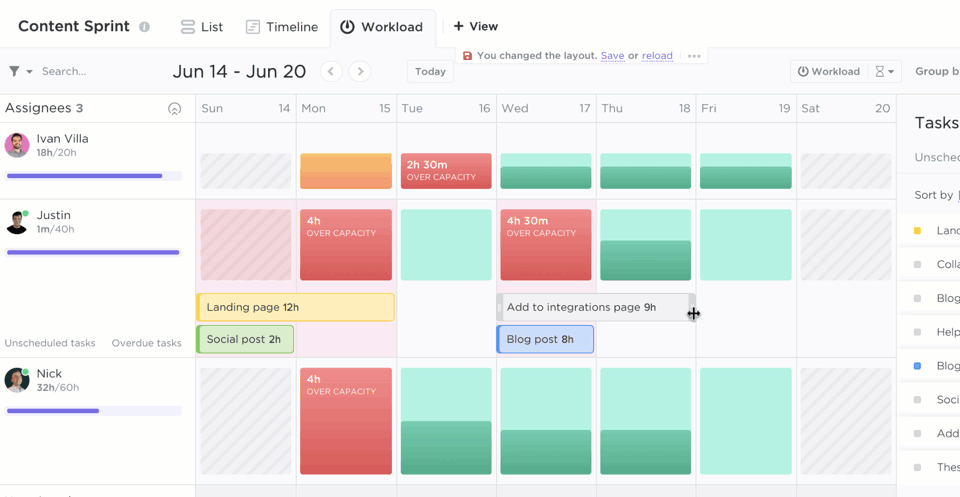
استخدم طريقة عرض عبء العمل في ClickUp لمعرفة من هو متقدم أو متأخر وسحب المهام وإفلاتها بسهولة لإعادة تخصيص الموارد
نحن هنا لعلاج هذه المشكلة من خلال 10 استراتيجيات لمساعدة مديري المشاريع على تجاوز ثغرات التنفيذ المحتملة وتسليم المشاريع دون عوائق.
مكافأة:_
_/href/ مدونة؟ ص=57766_ التخطيط للطوارئ *%/href/_
ما الذي يحدث خلال مرحلة تنفيذ المشروع بنجاح؟
- إسناد المهام: يقوم مدير المشروع بتعيين مهام محددة لأعضاء الفريق بناءً على مهاراتهم وخبراتهم.
- تنفيذ العمل: يقوم أعضاء الفريق بتنفيذ المهام الموكلة إليهم، باتباع خطة المشروع والجدول الزمني.
- تتبع التقدم المحرز: يراقب مدير المشروع التقدم المحرز في كل مهمة، مما يضمن إنجاز العمل كما هو مخطط له.
- التواصل والتعاون: يتواصل أعضاء الفريق بانتظام لمشاركة التحديثات ومعالجة التحديات وتنسيق الجهود.
- مراقبة الجودة: يتم تنفيذ عمليات ضمان الجودة لضمان أن مخرجات المشروع تفي بالمعايير المطلوبة.
- إدارة المخاطر: يحدد فريق المشروع المخاطر المحتملة التي قد تنشأ أثناء التنفيذ ويعالجها للحد من تأثيرها.
- إدارة الموارد: يضمن مدير المشروع توافر الموارد اللازمة، مثل المعدات والمواد والموظفين، واستخدامها بفعالية.
- إشراك أصحاب المصلحة: يحافظ فريق المشروع على التواصل المنتظم مع أصحاب المصلحة، وإبقائهم على اطلاع دائم ومعالجة أي مخاوف.
- إدارة التغييرات: في حالة حدوث تغييرات في نطاق المشروع أو متطلباته، يتم توثيقها وتقييمها وإدارتها وفقًا للإجراءات المتبعة.
- التوثيق وإعداد التقارير: يتم توثيق التقدم المحرز والمراحل الرئيسية وأي مشاكل تواجهها وإبلاغ أصحاب المصلحة المعنيين بها.
- حل المشاكل: يقوم فريق المشروع بتحديد وحل أي مشاكل أو تعارضات تنشأ أثناء التنفيذ، مما يضمن تقدم المشروع بسلاسة.
- المراقبة والتعديل المستمرين: يراقب مدير المشروع باستمرار تقدم المشروع، ويقوم بإجراء التعديلات حسب الضرورة لإبقائه على المسار الصحيح.
10 استراتيجيات تنفيذ المشروع
هناك الكثير من الخطوات الاستباقية التي يمكن اتخاذها قبل مرحلة تنفيذ المشروع لسد الفجوة بين أي أهداف أو استراتيجيات أو مهام غير متوائمة. ويكمن السر في تنفيذها في عملية إدارة مشروعك قبل أن يحين وقت العمل بوقت كافٍ! فيما يلي 10 من استراتيجيات تنفيذ المشاريع الناجحة المفضلة لدينا لإبقاء فريقك متحمسًا وعلى المسار الصحيح، والمضي قدمًا دائمًا.
1. استخدم برنامج إدارة المشروع
إذا كنت متردداً بشأن برنامج إدارة المشاريع ضروري لتنفيذ المشاريع بفعالية - إنه كذلك.
خاصة إذا كنت تقضي قدرًا كبيرًا من الوقت في التواصل مع أصحاب المصلحة، والعمل مع فرق متعددة الوظائف أو إدارة مشاريع متعددة في وقت واحد، فإن هذه الأدوات ستساعد في جلب الشفافية الكاملة للمشروع لجميع المعنيين دون الحاجة إلى إرسال بريد إلكتروني واحد.

تصور مهامك من كل زاوية مع أكثر من 15 طريقة عرض في ClickUp بما في ذلك القائمة واللوحة والتقويم
تُعد برامج إدارة المشاريع ضرورية حتى لمديري المشاريع المتمرسين للإشراف على الوقت وأعباء العمل والمشاريع، بل وحتى على سلامة العقل بأكثر الطرق إنتاجية ممكنة. تم تصميم هذه الأدوات للتخلص من الأعمال المزدحمة وتبسيط عمليات تخطيط المشاريع من خلال أتمتة سير العمل , تبعيات المهمة وواجهات السحب والإفلات والمزيد. 😍
أفضل أداة إدارة المشروع قابلة للتطوير، ومرنة، وبديهية - لذا بغض النظر عن حجم فريقك أو مدى تعقيد مشروعك، فإن البرنامج سيحقق النتائج دائماً. تتضمن الميزات الرئيسية المحددة التي يجب البحث عنها في برامج إدارة المشاريع عالية الجودة ما يلي:
- طرق عرض متعددة لدعملوحات كانبان,مخططات جانت التقليديةتقويمكالمخططاتوقوائم المهام والمزيد
- داخل التطبيقالتعاون ميزات مثل التعليقات، و@الإشارات، والدردشة، والمهام المخصصة، والمشاهدات
- لوحات المعلومات وإعداد التقارير الفورية لمنح مديري المشاريع فهماً عالي المستوى لحالة مشاريعهم بشكل عام
- حالات المهام المخصصة لنقل التقدم المحرز في أي بند من بنود العمل بشكل واضح ومرئي
- عمليات تكامل متعددة للمواءمة مع مجموعتك التقنية الحالية وجلب المزيد من المعلومات القيمة إلى منصة إدارة مشروعك
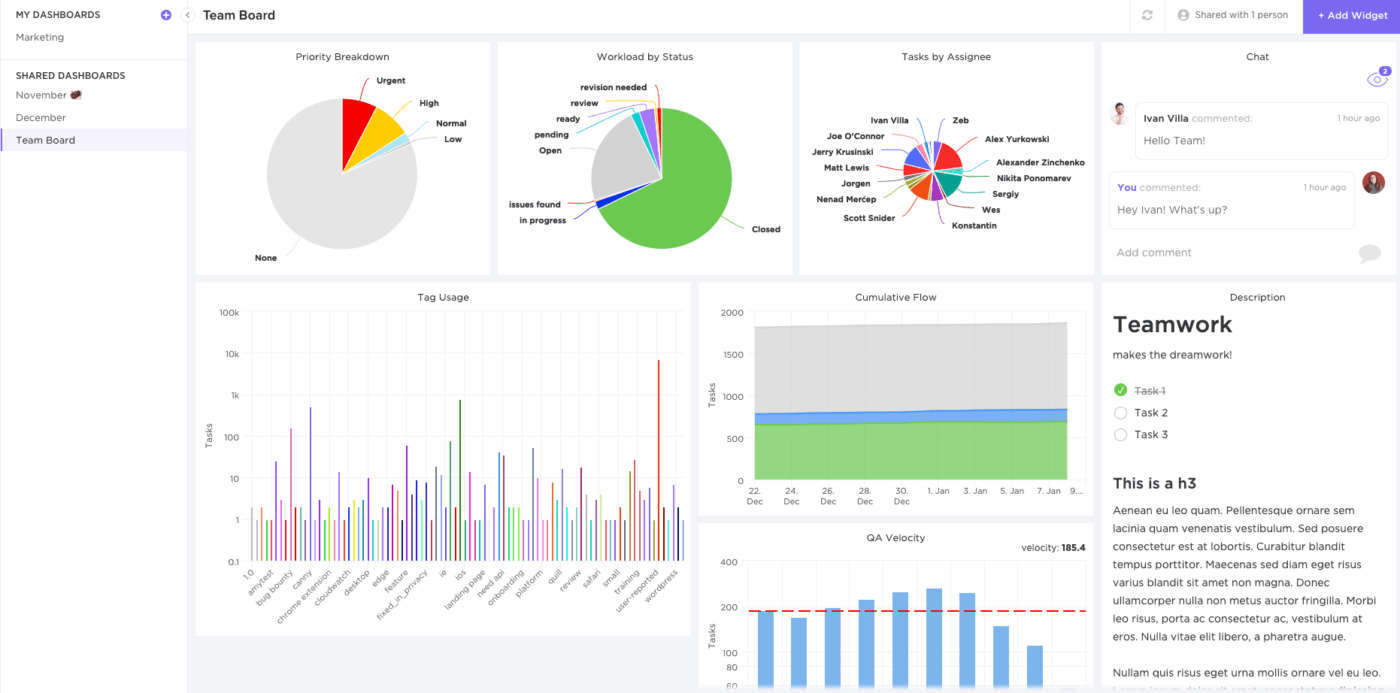
اسحب البيانات المهمة بسرعة على شاشة واحدة باستخدام لوحات المعلومات في ClickUp
على الرغم من أن هذه ليست سوى عدد قليل من ميزات إدارة المشاريع المفضلة لدينا، إلا أن هناك المزيد من الميزات التي يجب الانتباه إليها اعتمادًا على وضعك الفريد. تعد سهولة الاستخدام، وميزانية فريقك، والأدوات التي استثمرت فيها بالفعل من الأمور المهمة التي يجب مراعاتها قبل اختيار الحل المناسب. ولكن في هذه الصناعة المتنامية، من المهم أن تعرف أن لديك الكثير من الخيارات!
2. استخدم نماذج تخطيط المشاريع وتنفيذ المشاريع
_يمكنك العثور على قالب لأي شيء هذه الأيام
بجدية! لا يخفى على أحد أن كل أداة قوية لإدارة المشاريع تأتي مع مجموعة قوية من الميزات التي يجب اعتمادها. في نهاية المطاف، ستكون هذه الميزات أفضل صديق لك. لكن في الوقت الحالي؟ يمكن أن يكون تعلم أداة جديدة عملية في حد ذاته. تعمل القوالب على الحد من هذه المشكلة من خلال إطار عمل مصمم مسبقًا وقابل للتخصيص لبدء عملية تنفيذ مشروعك بأكثر الطرق إنتاجية ممكنة.
بالإضافة إلى ذلك، تعد القوالب طريقة رائعة لإظهار ما تم إنشاء ميزات برنامج إدارة مشروعك من أجله. الحالات المعدة مسبقًا، والجداول شبه المكتملة، وقوائم مهام تخطيط المشروع، ومستندات المساعدة هي بعض الطرق العديدة التي يمكن للقوالب من خلالها توجيه فريقك نحو النجاح.
أفضل نصيحة يمكن أن نقدمها لك بشأن القوالب هي أن تبدأ من هنا، مع قالب خطة تنفيذ المشروع من ClickUp .
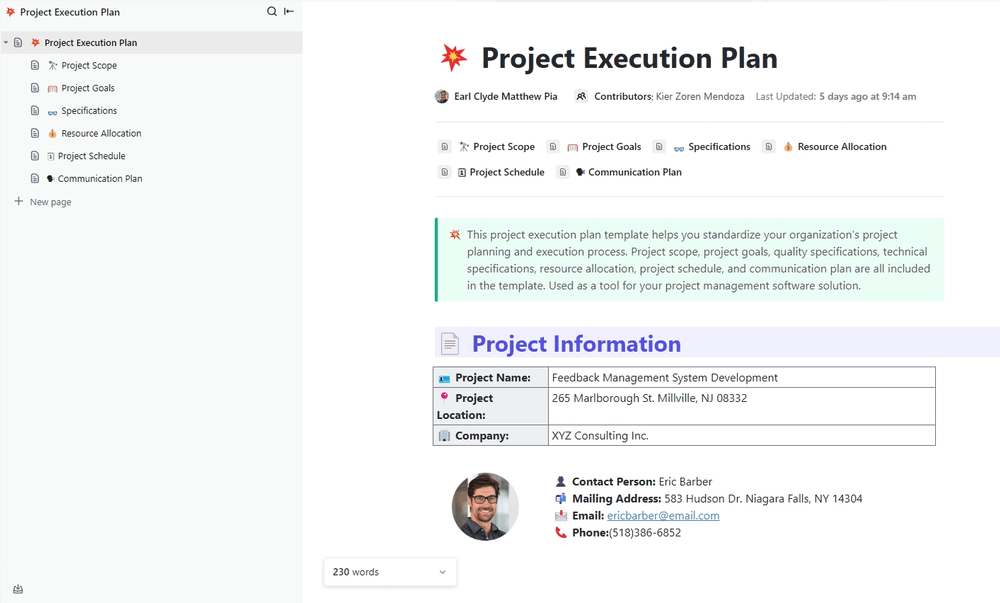
حدد نطاق مشروعك ومتطلباتك ومواردك والمزيد باستخدام قالب خطة تنفيذ المشروع من ClickUp
مستند ClickUp الملائم للمبتدئين هذا مليء بسبع صفحات من الأقسام القابلة للتخصيص من أجل وضع خطة تنفيذ المشروع بشكل استراتيجي وشامل تحديد نطاق مشروعك والأهداف، والمتطلبات، والجدول الزمني، وخطة التواصل، وغير ذلك. إنه المورد المثالي لمساعدة مديري المشاريع على توحيد عملية تنفيذ المشروع باستخدام محرر المستندات التعاوني والديناميكي من ClickUp - وهل ذكرنا أنه مجاني؟ 💸
فيما يلي بعض الميزات التي نحبها أكثر من غيرها مستندات ClickUp :
- يمكن تحويل نص من مستند ClickUp Doc الخاص بك مباشرة إلى مهمة قابلة للتنفيذ
- يمكن تفويض التعليقات إلى أعضاء آخرين بإشارة أو علامة بسيطة
- يمكن للفريق عرض التعليقات وتعديلها جنبًا إلى جنب دون تداخل باستخدامالكشف التعاوني المباشر وبما أن مستندات ClickUp Docs تظل محدثة تلقائيًا وتحفظ سجل الإصدار، فإن قالب تنفيذ المشروع الخاص بك سيكون دائمًا بمثابة مصدر موثوق للحقيقة لفريق المشروع للرجوع إليه في أي وقت. 😍
3. التوافق على أهداف تنفيذ المشروع
هذا لا يتعلق فقط بالاتفاق على الأهداف النهائية مخرجات المشروع ، يتعلق الأمر بمعرفة كيفية ارتباط المشروع برؤية مؤسستك على المدى الطويل.
سيؤدي فهم "السبب" وراء مشروعك إلى إبقاء فريق المشروع متوافقًا مع الاستراتيجية العامة والتأكد من تحديد أولويات المهام الصحيحة. يبدأ التواصل الواضح بالتواصل الواضح من خلال الاتفاق على نفس الصفحة حول الأمور قبل بدء التنفيذ. اجتماعات بدء المشروع , تحديد الأهداف الذكية ، وتحديثات التقدم المحرز رائعة لتعزيز الشفافية والثقة عبر الفريق عندما يتعلق الأمر بالوصول إلى الأهداف القصيرة والطويلة الأجل . بالإضافة إلى ذلك، فإنه يعزز التعاون في كل مرحلة من مراحل مشروعك من خلال ضمان عدم انغلاق كل عضو من أعضاء الفريق في صوامعهم الخاصة يومًا بعد يوم.
4. كن مبتكراً
عندما يتعلق الأمر بالأفكار الجديدة، لا يوجد الكثير من الطهاة في المطبخ - من المهم كمدير مشروع أن تمكّن الأعضاء من مشاركة أفكارهم.
إن أعضاء فريقك هم من يتولون زمام الأمور - فهم الذين يتنقلون في خرائط الطريق، ويتبعون الجدول الزمني، ويوفون بوعودهم. إنهم يعرفون ما يتحدثون عنه!
عند الدخول في مرحلة التنفيذ، قد تشعر بالتردد في الترحيب بالأفكار الجديدة خوفًا من تعريض الاستراتيجية التي قمت بإنشائها للتو للخطر. لكن التمحور جزء طبيعي من عملية المشروع. أنت وفريقك تشتركون في نفس النتائج، وسيذهب الأمر بعيدًا معهم عندما تعرف أن لديهم القدرة على التعبير عن أفكارهم واقتراحاتهم ومخاوفهم المحتملة بينما لا يزال هناك وقت للقيام بشيء ما حيال ذلك.
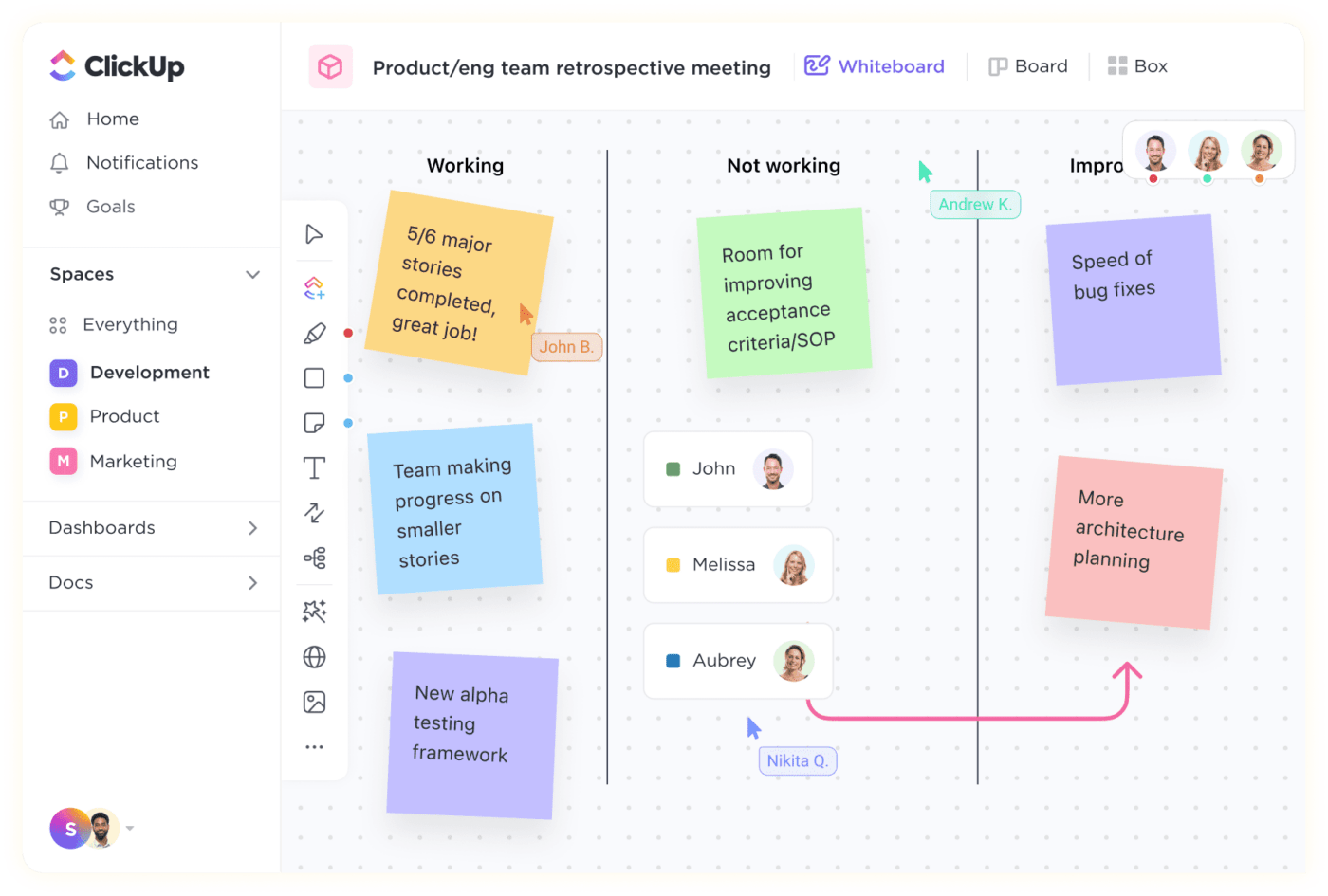
قم بالعصف الذهني والتخطيط ووضع الاستراتيجيات وتبسيط التواصل في الوقت الفعلي لشحن المشاريع بشكل أسرع باستخدام لوحات ClickUp Whiteboards
نماذج الأفكار, جلسات العصف الذهني ، وقنوات الاتصال المخصصة تشجع النقاش المفتوح بين الفريق وتظهر لهم أنك تهتم بما لديهم ليقولوه من خلال اتخاذ الخطوة الأولى. بدلًا من مجرد إخبارهم بأنك تتقبل أفكارهم، امنحهم الفرصة لطرح الأفكار أو المشاكل التي يواجهونها في أي مرحلة من مراحل التنفيذ - سيكون مشروعك دائمًا أفضل على المدى الطويل.
5. شجع مشاركة الأفكار
الأمر يسير في كلا الاتجاهين! إن تشجيع الفريق على مشاركة أفكارهم لا يقل أهمية عن التأكد من أنهم يشعرون بأنه يتم الاستماع إليهم. كمدير مشروع، لديك القدرة على مساعدة فريقك على إجراء تغييرات إيجابية من خلال أفكارهم. كن متقبلاً ومرناً مع أفكارهم، حتى لو كانت مختلفة عن الاستراتيجية الأصلية.
بالإضافة إلى ذلك، سيجعل ذلك الفريق يشعر بمزيد من المسؤولية عن عملهم إذا علموا أن أفكارهم تؤخذ في الاعتبار بجدية طوال العملية.
6. تفويض المهام لتنفيذ المشروع
على عكس الاعتقاد الشائع، لا ينبغي لمديري المشاريع أن يحملوا ثقل العالم على أكتافهم. فلديهم ما يكفي من القلق، وبصفتهم قائدًا للمشروع، فإن تفويض المهام إلى الأعضاء الآخرين سيعزز النمو والثقة من خلال مشاركة الملكية عبر الفريق.
من خلال تقسيم المسؤوليات حتى لو كانت صغيرة، يكون لدى مديري المشاريع المزيد من الوقت لفهم الصورة الكبيرة للأشياء بما في ذلك تقدم المشروع, أعباء عمل الفريق والحالة
7. تشجيع تعاون الفريق
تقع على عاتق مدير المشروع مسؤولية إبقاء الجميع على اطلاع على المستجدات من أعضاء الفريق الآخرين إلى أصحاب المصلحة.
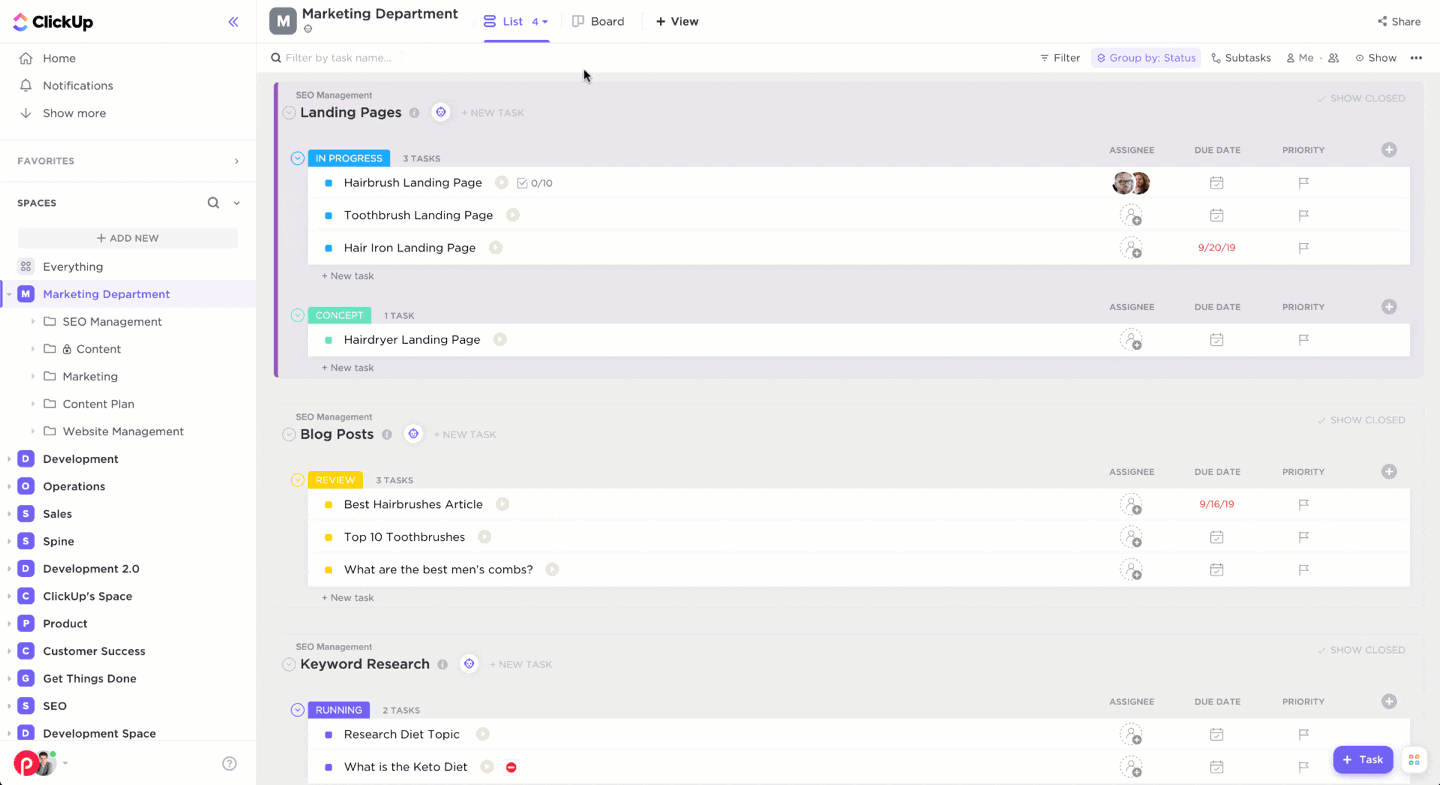
تخصيص إعدادات الخصوصية والمشاركة في أذونات ClickUp
الحوار البنّاء والمفتوح هو طريقة أخرى يمكن أن تساعد بها برامج إدارة المشاريع المديرين توفير الوقت وأن يكونوا أكثر كفاءة في أيامهم، ولكن لا يجب أن يكون ذلك محجوزًا دائمًا للاجتماعات ورسائل البريد الإلكتروني. حافظ على الشفافية الكاملة لحالة مشروعك من خلال منح اللاعبين الرئيسيين لديك إمكانية الوصول إلى عرض التقارير عالية المستوى أو مستندات التقدم أو التعليق عليها أو حتى تحريرها على النحو الذي تراه مناسبًا.
8. تحديد تبعيات المهام
تساعد معرفة المهام التي يجب إكمالها بترتيب معين على بقاء المشاريع على المسار الصحيح وتخصيص الموارد بشكل صحيح. وبالنظر إلى أن معظم الثغرات الاستراتيجية تعود إلى عدم وجود إدارة الموارد على مستوى ما، والبقاء على رأس تبعيات مهامك, المعالم و المسار الحرج يمكن أن يكون في بعض الأحيان الفرق بين ما إذا كان المشروع سينجح في مرحلة التنفيذ أم لا.
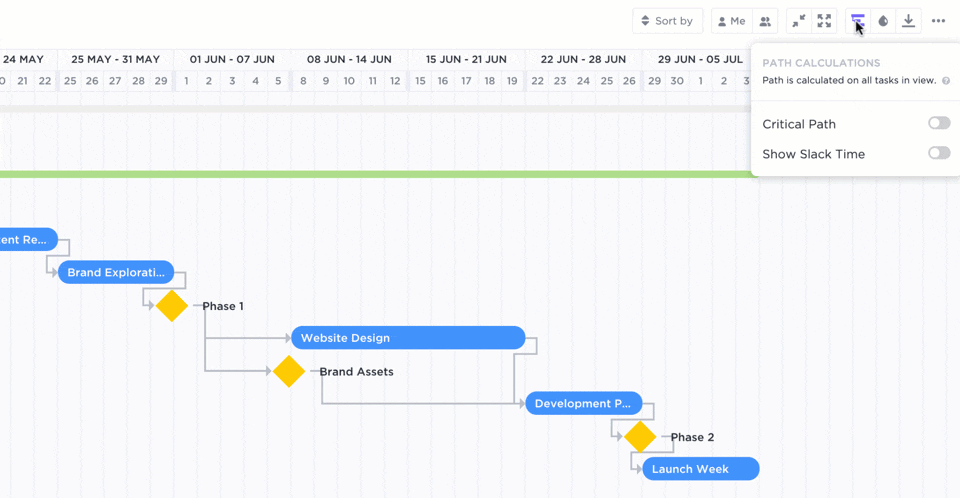
اعرض عبء العمل الخاص بك حسب المهام المتبقية في مسارك الحرج باستخدام مفتاح تبديل واحد في ClickUp!
9. تتبع التقدم المحرز في تنفيذ المشروع
من الأفضل أن تُخطئ في اختيار المزيد من حلول إدارة المشاريع المرئية عندما يتعلق الأمر بلوحات المعلومات وإعداد التقارير والرؤى. هناك الكثير من الطرق لتحديد الحالة العامة لمشروعك، حتى على المستوى الدقيق، عند استخدام البرنامج المناسب.
تعد ميزات مثل حالات المهام المخصصة ممتازة لفهم تحديثات المهام الفردية بسرعة في لمحة، ولكن بالنسبة للتقدم عالي المستوى، فإن لوحات المعلومات والرسوم البيانية و اللوحات البيضاء الرقمية هي الوسيلة المفضلة لكل مدير مشروع. من المزايا الأخرى لاستخدام الأشكال المرئية للغاية لإعداد التقارير أنها أسهل في القراءة وأكثر سهولة في الوصول إلى أصحاب المصلحة والرؤساء ورؤساء الأقسام الأخرى لفهمها في وقت قصير.
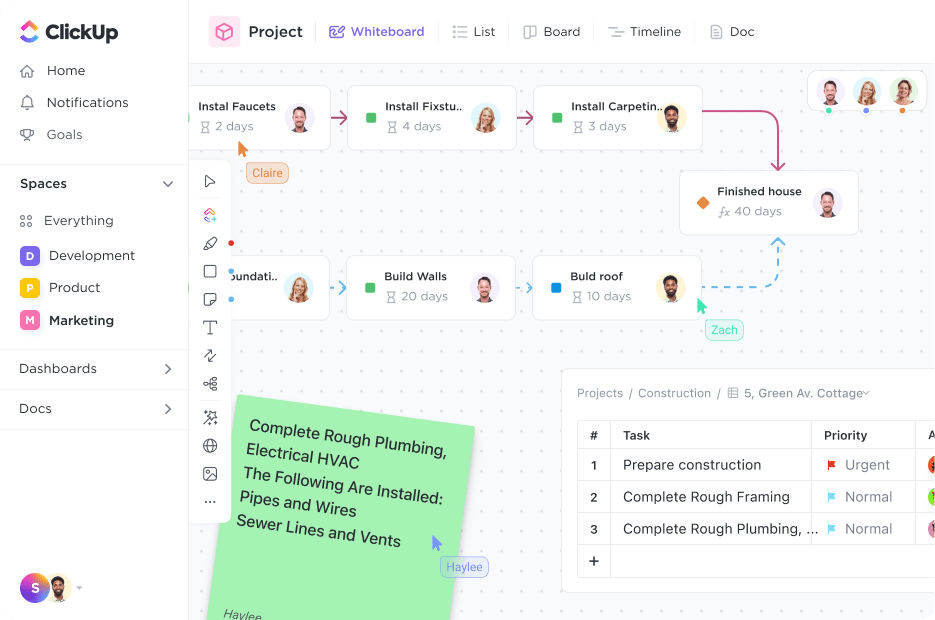
استخدم لوحات ClickUp Whiteboards كأداة تعاون مرئي لأي حاجة
10. مراجعة المخرجات مع أصحاب المصلحة
بعد أي من هذه استراتيجيات تؤدي إلى إدارة أفضل للوقت وزيادة الإنتاجية مع تجنب ثغرات التنفيذ في إدارة المشاريع. إذن، ماذا يجب أن تفعل بالوقت الجديد الذي وفرته؟ استخدمه للتأكد من أن أصحاب المصلحة الرئيسيين سعداء في كل خطوة على الطريق!
على الرغم من أن ذلك قد لا يكون ضرورياً أو ممكناً دائماً، إلا أن مراجعة مخرجات المشروع مع أصحاب المصلحة خلال مرحلة التنفيذ تضمن رضاهم عند الانتهاء من المشروع. بالإضافة إلى أن ذلك يجعلك تبدو جيداً!
خاصةً إذا كنت تعمل مع عملاء جدد، فإن هذه اللفتة تعزز من قوة العلاقات مع أصحاب المصلحة ويطمئن فريقك أنهم يسيرون في الاتجاه الصحيح.
كيف تساعد برامج إدارة المشاريع على تنفيذ المشروع
إذا كنت ستستخلص أي شيء من هذا الدليل، فليكن أهمية برامج إدارة المشاريع الديناميكية لتبسيط وأتمتة عملية تنفيذ مشروعك.
إن استثمار وقتك ومواردك في البرنامج المناسب سيساعدك على متابعة جميع استراتيجيات التنفيذ العشرة هذه بسهولة وكفاءة، بغض النظر عن نوع مشروعك أو مدى تعقيده.
مع وجود مكتبة القوالب لاستكمال ثرائها مجموعة من الميزات , انقر فوق هو البرنامج المثالي لمساعدة المديرين وفرق العمل على تنفيذ المشاريع، وتبسيط العمليات، والمواءمة بين الأهداف الرئيسية. إنه المنصة الإنتاجية الوحيدة القوية بما يكفي لجعل العمل عبر التطبيقات في مركز تعاوني واحد.
 مراقبة تحديثات المشروع
وإدارة مهام سير العمل والتعاون مع الفريق، كل ذلك من مساحة عمل ClickUp الخاصة بك
مراقبة تحديثات المشروع
وإدارة مهام سير العمل والتعاون مع الفريق، كل ذلك من مساحة عمل ClickUp الخاصة بك
ومع ميزات تشمل مستندات ClickUp , اللوحات البيضاء ClickUp مع طرق العرض المتعددة، والحالات المخصصة المتاحة في كل خطة تسعير، فإن ClickUp تنشئ حلولاً للفرق من أي ميزانية. اشترك في ClickUp اليوم وابدأ في استخدامه مع الفريق دون أي تكلفة على الإطلاق.

